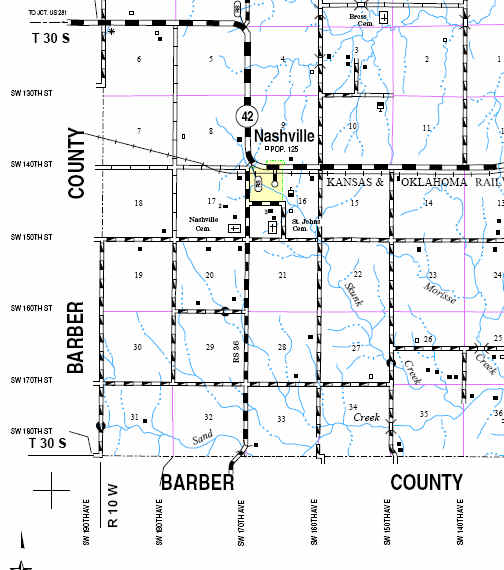
Nashville orginated in 1885 and was so named,
because some settlers came from Nashville, Tennessee. In the late 1870's, there
was hardly anyone living in the area. The good grassland, between Sand Creek and
the Chikaskia River, was used by a few ranches. Cattle herds grazed together,
since fences were unlawful on public land. Stage line tracks on the trail are
still visible in the pastures in the vicinity of Nashville. Until the farm land
was occupied and fenced, there were few if any roads.
With the building of the Atchison, Topeka and
Santa Fe Railroad through Nashville, it developed into a thriving community.
Pens by the railroad tracks were used for loading, unloading and selling cattle
and wild horses. Other early businesses included: Frank Krengel's Livery and
Feed Barn; Kennedy's Grocery, which also served as a bank until 1907 and
provided a corner for the post office; State Bank operated by Halls, Hemphill
and Mrs. Phiel; Figge-Bennett General Store; Stewart-Larabee Hardware; McNabb
Barber Ship, Johnson's Store; Clyde Waiter's Gazette; Twyman-Gray Store; J.J.
Lawrence Real Estate; Louthan Blacksmith Shop; hotel; Townsend Restaurant;
Elliott Brothers Dry Goods; J.B. Hewitt, builder, Ben Hudson Oakland Dealership;
electric plant, which operated from sundown to ten o'clock; Larabee Model-T
Agency; telephone system built by Everett Dafforn; produce and cream station;
and Larabee Dodge Agency.
Dr. J.B. Morton practiced from 1909 to 1933. He
built a small hospital in 1926. Dr. D.C. McCarty took over Dr. Morton's
practice. He was followed by Dr. T.L. Waylan and his wife, Frances, a registered
nurse, who diligently cared for patients until 1981, when they retired. The
hospital closed a few years earlier.
Many of the settlers, of German descent, had
relocated on the Kansas prairie, seeking new homes, farm land, and a place to
worship. They worshipped in a schoolhouse, until the first Lutheran Church was
erected. Those in and around Nashville were part of the Missouri Lutheran Synod.
Their early church was replaced by a larger structure, which is still used. The
Methodist Sunday School was organized in 1889 and met in a schoolhouse until
1912, when their church was built. Also in 1889, the Presbyterian worshippers
organized, and likewise used a schoolhouse for worship services. In 1907, their
church edifice was completed and dedicated. The Methodist and Presbyterian
congregations merged in 1957, using the Presbyterian Church.
In 1984, Nashville has a post office; elevator;
general store; gas-repair-service-garage; Joe Strong Insurance and Real Estate
Agency; Lutheran and Presbyterian churches and a grade school. The population is
143.
http://skyways.lib.ks.us/counties/KM/nashville.html
St. John Cemetery
Nashville,
Kingman County, Kansas
Submitted by Oz
| Name | Birth Date | Death Date | Other Information |
| Grabs, Mary | 5-9-1910 | 1-21-2006 | b. Marienthal ks Wichita co, d. Anthony ks Harper co, D/O Matthew and Frances Lichter. On Oct. 7, 1930, she married Fredrick W. Grabs in Marianthal. He died Jan. 5, 1969. She was preceded in death by three brothers; and two sisters. |
|
Lampe, Leroy E.
|
7-28-1939 | 11-1-2004 | b. Isabel KS Barber co, d. Argonia KS Sumner co, S/O late Alvin and Hulda (Winter) Lampe. He was a graduate of Nashville High School in 1957, Pratt Junior College in 1959, received his Bachelor of Science Education and Major in Mathematics in 1961, Masters in Education in 1971 all at Northwestern State College. He was a retired math teacher and counselor for 36 years at Argonia High School. He was a member of St. John Lutheran Church, Nashville. Preceded in death by niece, Rhonda Mease. |
